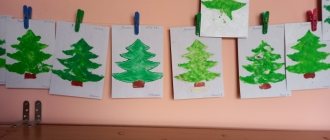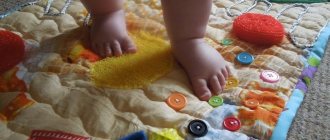Quest experience
Municipal budgetary preschool educational institution
d/s ORV “Malysh”, Usman
Experience on the topic:
“Quest technology in the educational process of preschool educational institutions”
Prepared by: Demikhova Lyudmila Yurievna
2020
Relevance
: From birth, a modern child is surrounded by a rich information environment. Computers, game consoles, and electronic toys occupy an increasingly important place in the life of a preschooler. It is increasingly difficult to surprise modern children with anything. This, of course, leaves a certain imprint on the development of the child’s personality. I try to keep up with the times and use modern means of training and development, new pedagogical methods and technologies, and original forms of educational activities in my work. The most appropriate technology for the needs and interests of preschool children, in my opinion, is quest technology, which meets modern requirements and preserves play in the space of preschool childhood.
In English, “quest” means “search”, “wanted object”. Quest technology is considered as an interactive educational environment for enhancing the educational activities of preschool children. Over the past two years, this form has been of interest to me and to the specialists of our preschool educational institution.
The main feature of the quest is the goal, which can be reached by consistently solving riddles. Each riddle is the key to the next point and the next task.
Tasks can be very different: research, creative, cognitive, intellectual. Novelty: Quest technology - relevant in the context of the requirements of the Federal State Educational Standard for Educational Education; promotes the development of an active, active position of the child in the process of solving game search problems. The content of various educational areas is integrated, and the capabilities of ICT are used.
Quests have a large number of advantages for preschool children, which in many areas fully comply with the Federal State Educational Standard for Education: quests naturally integrate educational areas, combine different types of children's activities and forms of work with children. Quests allow you to unite all participants in the educational process (children, parents of students, educators, specialists) in solving educational problems in a playful and entertaining form.
The purpose of my work
: to create conditions for interactive interaction of all participants in the educational process through setting search tasks in the course of organizing activities through a certain plot.
In order to achieve this goal, I solved the following tasks:
-Identified the advantages and features of using quest games in working with preschool children;
— Included a quest game in the practice of working with preschool children;
— Ensured the relationship between all participants in the educational process (children, parents, teachers, specialists) through the inclusion of quest games in the work.
The theoretical basis of my work was the research of domestic and foreign scientists and teachers. Sokol I.N. in her works she described the basic conditions for preparing quests for preschoolers, which distinguish children's educational quests from quests for adults. She highlighted the features of children's quests, and for organizing and conducting quests she developed the structure of quests and an algorithm for their construction. She described in detail the principles that must be taken into account when developing them.
Having studied this technology, talked with the author and creator of quest games, Yu. Lugovskaya, for the past two years I have been incorporating quest games into the educational process, which I build systematically, step by step in four directions: working with children, working with parents of students, working with teachers, creation of a developing subject-spatial environment. I use quest games as part of continuous educational activities and leisure activities with children. I conduct most of the quests with the active participation of the students’ parents.
I conduct quest games with children of the second junior and preparatory groups. Recommendations for conducting continuous educational activities with children 6-7 years old using a didactic manual are very popular among my colleagues.
Of particular interest to my students are thematic quests, such as “In Search of Treasures”, “In the Footsteps of Bigfoot”, “Journey to the Queen of Mathematics”, “In Search of Wild Animals”, I conduct quests to teach children traffic rules, “Young Driver” ", "On the path of safety." The role of quest technologies in the modern world simply cannot be underestimated. Of course, it is possible to force a child to cram, but, as you know, nothing good will come of it. Roughly speaking, he will remember a certain uninterpreted set of knowledge, but when an understanding of this or that process comes, that’s a different matter. And, I must say, children are sometimes able to remember material even on a subconscious level. And if the process is also presented in a playful form, then no one will refuse to participate in it.
In kindergarten, with my colleagues, I organize creative, educational, literary, and sports quests. The quest dedicated to the Day of Knowledge “Journey to the Tree of Knowledge”, which was conducted with the participation of parents, became interesting and memorable. To familiarize teachers with quest technology, various master classes were held, such as “Quest about quests,” “5 steps to mastering quests,” a workshop on “basic approaches to quest technology and experience of its use in the educational process,” and a survey.
Quests have become an interesting basis for methodological support for the implementation of the Federal State Educational Standard for Education in working with teachers. Quest technology has found its application in working with parents of students. Conducted and compiled recommendations for holding parent meetings in quest format.
The highlight of my experience is the manuals for conducting quest games. Quests require a lot of preparation, a well-thought-out subject-spatial environment, a large number of details that will encourage children to independently search for and solve problem situations. The first developments on this topic showed that in the process of introducing quest technology into practice in kindergarten: - an atmosphere of emotional uplift and emancipation is created for all participants in the educational process; — educators and specialists began to show sincere interest in children’s achievements; - children develop confidence in themselves and their comrades; the feeling of fear for making a mistake is removed - children of the preparatory group know how to listen and hear each other, express their opinions, negotiate, come to agreement; Children have developed speech interaction; a positive attitude towards the surrounding world, other people, oneself, and peers has been formed; children know how to defend their position and object to adults reasonably and kindly; they have no sense of fear for making a mistake. Thus, the quest became an excellent opportunity for me and the children to organize life in kindergarten in a fun and original way. Quest provides me with invaluable assistance, providing the opportunity to diversify the educational process, making it unusual, memorable, exciting, fun, and playful. Dear colleagues, if you are interested in my work experience, I will be very happy to share it with you.






